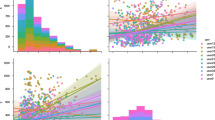Abstract
The era of modern personal and ubiquitous computers is beset with the problem of fragmentation of the user’s time between multiple tasks. Several adaptations have been envisioned that would support the performance of the user in the dynamically changing contexts in which interactions with mobile devices take place. This paper assesses the feasibility of sensor-based prediction of time-sharing, operationalized in terms of the number of glances, the duration of the longest glance, and the total and average durations of the glances to the interaction task. The data used for constructing and validating the predictive models was acquired from a field study (N = 28), in which subjects performing mobile browsing tasks were observed for approximately 1 h in a variety of environments and situations. The predictive accuracy achieved in binary classification tasks was about 70% (about 20% above default), and the most informative sensors were related to the environment and interactions with the mobile device. Implications to the feasibility of different kinds of adaptations are discussed.
Similar content being viewed by others
References
Adamczyk, P.D., Bailey, B.P.: If not now, when? The effects of interruption at different moments within task execution. In: Proceedings of the ACM Conference on Human Factors in Computing Systems (CHI 2004), pp. 271–278. ACM Press, New york (2004)
Altmann, E.M., Trafton, J.G.: Task interruption: resumption lag and the role of cues. In: Proceedings of the 26th Annual Conference of the Cognitive Science Society, pp. 42–47. Lawrence Erlbaum Associates, Hillsdale, NJ (2004)
Begole, B., Tang, J., Hill, R.: Rhythm modeling, visualizations and applications. In: Proceedings of the 16th Annual ACM Symposium on User Interface Software and Technology, pp. 11–20. ACM Press, New York (2003)
Burgess P.W. (2000). Strategy application disorder: the role of the frontal lobes in human multitasking. Psychol. Res. 63: 279–288
Carberry S. (2001). Techniques for plan recognition. User Model. User-Adapt. Interact. 11(1–2): 31–48
Card, S.K., Henderson, A.: A multiple, virtual-workspace interface to support user task switching. In: Proceedings of the ACM Conference on Human Factors in Computing Systems (CHI 1987), pp. 53–59. ACM Press, New York (1987)
Cutrell, E., Czerwinski, M., Horvitz, E.: Notification, disruption, and memory: effects of messaging interruptions on memory and performance. In: Proceedings of Interact 2001: IFIP Conference on Human-Computer Interaction, pp. 263–269. IOS Press, Amsterdam (2001)
Dourish, P., Bellotti, V.: Awareness and coordination in shared workspaces. In: Proceedings of the ACM Conference on Computer-Supported Cooperative Work (CSCW 1992), pp. 107–114. ACM Press, New York (1992)
Eng, K., Lewis, R.L., Tollinger, I., Chu, A., Howes, A., Vera, A.: Generating automated predictions of behavior strategically adapted to specific performance objectives. In: Proceedings of the ACM Conference on Human Factors in Computing Systems (CHI 2006), pp. 621–630. ACM Press, New York (2006)
Fischer G. (2001). User modeling in human-computer interaction. User Model. User-Adapt. Interact. 11(1): 65–86
Fogarty, J., Ko, A.J., Aung, H.H., Golden, E., Tang, K.P., Hudson, S.E.: Examining task engagement in sensor-based statistical models of human interruptibility. In: Proceedings of the ACM Conference on Human Factors in Computing Systems (CHI 2005), pp. 331–340. ACM Press, New York (2005)
Fogarty, J., Lai, J.: Examining the robustness of statistical models. In: Proceedings of the ACM Conference on Human Factors in Computing Systems (CHI 2004), pp. 207–214. ACM Press, New York (2004)
Fogarty J., Lai J. and Christensen J. (2004). Presence versus availability: the design and evaluation of a context-aware communication client. Int. J. Hum.-Comput. Stud. 61(3): 299–317
Fu W.T. and Gray W.D. (2004). Resolving the paradox of the active user: stable suboptimal performance in interactive tasks. Cogn. Sci. 28(6): 901–935
Glanzer M., Dorfman D. and Kaplan B. (1981). Short-term processing in the processing of text. J. Verbal Learn. Verbal Behav. 20: 656–670
González, V.M, Mark G.: Constant, constant, multi-tasking craziness: managing multiple working spheres. In: Proceedings of the ACM Conference on Human Factors in Computing Systems (CHI 2004), pp. 113–120. ACM Press, New York (2004)
Gray W.D. and Boehm-Davis D.A. (2000). Milliseconds matter: an introduction to microstrategies and to their use in describing and predicting interactive behavior. J. Exp. Psychol. Appl. 6(4): 322–335
Guyon I. and Elisseeff A. (2003). An introduction to variable and feature selection. J. Mach. Learn. Res. 3: 1157–1182
Hjorth J. (1994). Computer Intensive Statistical Methods: Validation, Model Selection and Bootstrap. Chapman & Hall, London
Ho, J., Intille, S.S.: Using context-aware computing to reduce the perceived burden of interruptions from mobile devices. In: Proceedings the ACM Conference on Human Factors in Computing Systems (CHI 2005), pp. 909–918. ACM Press, New York (2005)
Horvitz, E.: Principles of mixed-initiative user interfaces. In: Proceedings of the ACM Conference on Human Factors in Computing Systems (CHI 1999), pp. 159–166. ACM Press, New York (1999a)
Horvitz E. (1999). Uncertainty, action and interaction: in pursuit of mixed-initiative computing. IEEE Intell. Syst. 14(5): 17–20
Horvitz, E., Apacible, J.: Learning and reasoning about interruption. In: Proceedings of the Fifth International Conference on Multimodal Interfaces (ICMI 2003), pp. 20–27. ACM Press, New York (2003)
Horvitz, E., Jacobs, A., Hovel, D.: Attention-sensitive alerting. In: Proceedings of the Fifteenth Conference on Uncertainty in Artificial Intelligence (UAI’99), pp. 305–313. Morgan Kaufmann, San Francisco, CA (1999)
Horvitz E., Kadie C.M., Paek T. and Hovel D. (2003). Models of attention in computing and communications: from principles to applications. Commun. ACM 46(3): 52–59
Hudson, S., Fogarty, J., Atkeson, C., Avrahami, D., Forlizzi, J., Kiesler, S., Lee, J., Yang, J.: Predicting human interruptibility with sensors: a wizard of oz feasibility study. In: Proceedings of the ACM Conference on Human Factors in Computing Systems (CHI 2003), pp. 257–264. ACM Press, New York (2003)
Jameson, A., Kiefer, J., Mueller, C., Grossmann-Hutter, B., Wittig, F., Rummer, R.: Assessment of a user’s time pressure and cognitive load on the basis of features of speech. Technical report, German Research Institute for Artificial Intelligence, Saarbrücken, Germany (2006)
Jameson A. and Klöckner K. (2005). User multitasking with mobile multimodal systems. In: Minker, W., Bühler, D. and Dybkjær, L. (eds) Spoken Multimodal Human-Computer Dialogue in Mobile Environments, pp 349–377. Springer, Dordrecht
Jameson A., Schaefer R., Weis T., Berthold A. and Weyrath T. (1999). Making systems sensitive to the user’s changing resource limitations. Knowledge-Based Syst 12: 413–425
Kern, N., Antifakos, S., Schiele, B., Schwaninger, A.: A model for human interruptability: experimental evaluation and automatic estimation from wearable sensors. In: Proceedings of the Eighth International Symposium on Wearable Computers (ISWC’04), pp. 158–165. IEEE Computer Society, Washington, DC (2004)
Kern, N., Schiele B.: Context-aware notification for wearable computing. In: Proceedings of the 7th IEEE International Symposium on Wearable Computers (ISWC’03), pp. 223–230. IEEE Computer Society, Washington, DC (2003)
Kobsa A. (2001). Generic user modeling systems. User Model. User-Adap. Interact. 11(1–2): 49–63
Kohavi R. and John G. (1997). Wrappers for feature selection. Artif. Intell. 97(1–2): 273–324
Kushleyeva Y., Salvucci D. and Lee F.J. (2005). Deciding when to switch tasks in time-critical multitasking. Cogn. Syst. Res. 6: 41–49
Mäntyjärvi J. and Seppänen T. (2003). Adapting applications in handheld devices using fuzzy context information. Interact. Comput. 15(4): 521–538
McFarlane D.C. and Latorella K.A. (2002). The scope and importance of human interruption in human-computer interaction design. Hum. Comput. Interact. 17(1): 1–61
Miyata Y. and Norman D.A. (1986). Psychological issues in supporting multiple activities. In: Norman, D.A. and Draper, S.W (eds) User Centered Design: New Perspectives on Human-Computer Interaction, pp 266–284. Lawrence Erlbaum Associates, Hillsdale, NJ
Monsell S. (2003). Task switching. Trends Cogn. Sci. 7(3): 134–140
Näätänen R. (1992). Attention and Brain Function. Lawrence Erlbaum Associates, Hillsdale, NJ
Oulasvirta A., Petit R., Raento M. and Tiitta S. (2007). Interpreting and acting on mobile awareness cues. Hum.-Comput. Interact. 22(1&2): 97–135
Oulasvirta, A., Tamminen, S., Roto, V., Kuorelahti, J.: Interaction in 4-second bursts: the fragmented nature of attentional resources in mobile HCI. In: Proceedings of the ACM Conference on Human Factors in Computing Systems (CHI 2005), pp. 919–928, ACM Press, New York (2005)
Pashler H. (1993). Dual-task interference and elementary mental mechanisms. In: Meyer, D. and Kornblum, S. (eds) Attention and Performance XIV, pp 245–264. MIT Press, Cambridge, MA
Russell S. and Norvig P. (2003). Artificial Intelligence: A Modern Approach (2nd edn). Pearson Education, Upper Saddle River, NJ
Salovaara, A., Oulasvirta, A.: Six modes of proactive resource management. In: Proceedings of NordiCHI 2004, pp. 57–60. ACM Press, New York (2004)
Salvucci D. (2005). A multitasking general executive for compound continuous tasks. Cogn. Sci. 29: 257–292
Simon H. (1971). Designing organizations for an information rich world. In: Greenberger, M. (eds) Computers, Communications and the Public Interest, pp 37–72. Johns Hopkins University Press, Baltimore, MD
Tamminen S., Oulasvirta A., Toiskallio K. and Kankainen A. (2004). Understanding mobile contexts. Pers. Ubiquitous Comput. 8(2): 135–143
Vera, A., Howes, A., McCurdy, M., Lewis, R.L.: A constraint satisfaction approach to predicting skilled interactive cognition. In: Proceedings of the ACM Conference on Human Factors in Computing Systems (CHI 2004), pp. 121–128. ACM Press, New York (2004)
Vertegaal R. (2003). Attentive user interfaces. Commun. ACM 46(3): 31–33
Wickens C.D. (1984). Processing resources in attention. In: Parasuraman, R. and Davies, R. (eds) Varieties of Attention, pp 63–102. Academic Press, New York
Wickens C.D. (2002). Multiple resources and performance prediction’. Theor. Issues Ergon. Sci. 3(2): 159–177
Wikman A.S., Nieminen T. and Summala H. (1998). Driving experience and time-sharing during in-car tasks on roads of different width. Ergonomics 41: 358–372
Author information
Authors and Affiliations
Corresponding author
Rights and permissions
About this article
Cite this article
Miettinen, M., Oulasvirta, A. Predicting time-sharing in mobile interaction. User Model User-Adap Inter 17, 475–510 (2007). https://doi.org/10.1007/s11257-007-9033-x
Received:
Revised:
Accepted:
Published:
Issue Date:
DOI: https://doi.org/10.1007/s11257-007-9033-x




